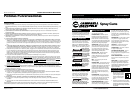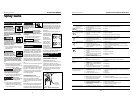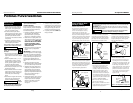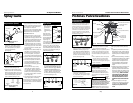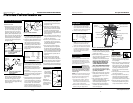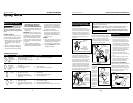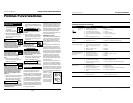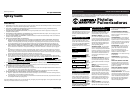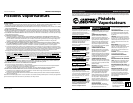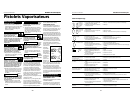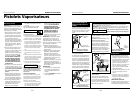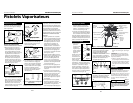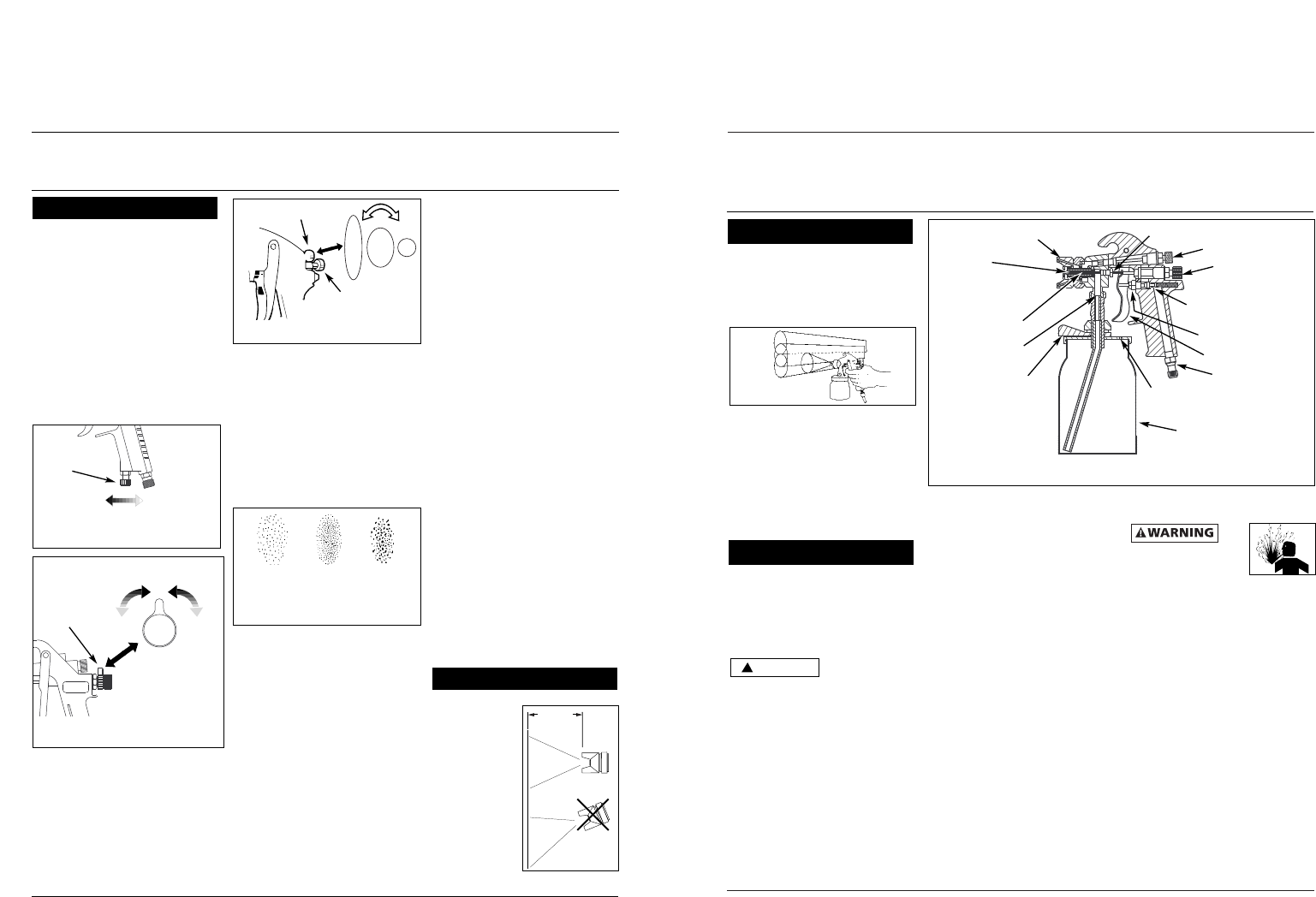
5
Operating Instructions
Air Operated Models
3. The amount of paint being applied
can be varied by the speed of the
stroke, distance from the surface and
adjustment of the fluid control knob.
4. Overlap strokes just enough to
obtain an even coat (See Figure 14).
NOTE: Two thin coats of paint will
yield better results and have less
chance of runs than one heavy layer.
5. Use a piece of cardboard as a shield
to catch overspray at the edges of
the work to protect other surfaces.
Use masking tape to cover other
areas if needed.
DAILY CLEAN-UP
Local codes may require specific clean-
ing methods and equipment. Follow
local codes and manufacturer’s recom-
mendations for the use and disposal of
spray materials and solvent.
Clean spray gun
immediately after
use. Paint and other material dry quick-
ly in the small passages rendering gun
useless due to the difficulty of remov-
ing hardened paint from the passages
inside the gun.
NOTE: In the instructions below, the use
of the word “solvent” refers to the spe-
cific solvent for the material used (eg:
lacquer thinner for lacquer, etc ).
1. Spray guns with canister—Remove
and empty the canister; then rinse
with a solvent recommended for the
paint or other material used.
2. Refill canister with clean solvent and
attach to the gun. Spray solvent
!
NOTICE
through the gun while shaking the
gun vigorously. Wipe the gun exteri-
or with a solvent soaked rag. Repeat
until the gun is clean.
3. Remove the air cap and soak in sol-
vent until clean. Use a small brush for
stubborn stains if necessary.
Toothpicks or small brushes may be
used to clean air passages; however,
NEVER USE METAL OBJECTS TO
CLEAN PRECISELY DRILLED PAS-
SAGES. DAMAGED PASSAGES
WILL CAUSE IMPROPER SPRAYING.
4. Clean gaskets with a solvent soaked
rag. To prevent equipment damage,
Do not immerse gaskets or spray
gun body in solvents.
5. After using water to clean out water
based paints or materials, spray min-
eral spirits through the gun to pre-
vent corrosion.
6. Use a non-silicone oil on all moving
parts when reassembling. Use
Vaseline
®
or light grease on all thread-
ed connections prior to storage.
7. Clean and flush gun thoroughly to
neutralize any contaminants corro-
sive to the spray gun.
Figure 14
CLEANING A GUN USED WITH A PAINT
TANK
Shut off the air supply to
the tank and release the
pressure in the tank.
1. Open the vent on the paint tank. If
using an external mix air cap, loosen
the cap slightly.
2. Reduce air pressure to 10-20 PSI. Hold
a piece of cloth, wadded in the hand,
tightly around the air cap opening(s)
and pull the trigger. The air will back
up through the fluid tip and force
the paint out of the hose and back
into the tank.
3. Pour the paint from tank and use sol-
vent and rags to clean.
4. Put enough solvent into the tank to
wash the hose and gun thoroughly.
Close the tank and spray from the
gun until the solvent comes out clean.
5. Remove and blow out the material
hose with compressed air to get rid
of any trace of solvent in the hose.
Figure 15 - Conventional Siphon Spray Gun
Air Cap
Fluid Tip
(Nozzle)
Fluid Needle
Fluid Inlet
Cup Lid Clamp
Cup
Vent Hole
1/4” NPS
Air Inlet
fitting
Trigger
Air Valve
Fluid Control Knob
Pattern Control Knob
Packing Nut (Fluid Needle)
Packing Nut (Air Valve)
4 Sp
Manual de Instrucciones
Pistolas Pulverizadores Neumáticas
Pistolas Pulverizadoras
PARA AJUSTAR EL PATRON
SISTEMAS DE SIFON
1. Ajuste la presión de aire de la pistola
pulverizadora según las recomenda-
ciones suministradas con el material
que va a rociar. Esta presión general-
mente es entre 2,8 - 4,1 bar. Para
ajustar la presión de aire oprima el
gatillo y abra completamente la per-
illa de control de aire (de haberla). Si
desea reducir la presión para pintar
sólo ciertas áreas, use la perilla de
control de aire para reducirla (Vea
las Figuras 7 ó 8).
2. Seleccione la forma del patrón. Si
desea cubrir una superficie amplia,
gire la perilla de control en sentido
contrario a las agujas del reloj. Si
desea un patrón circular, gírela en el
mismo sentido de las agujas del reloj
(Vea la Figura 9).
3. Gire la perilla de control totalmente
en el mismo sentido de las agujas del
reloj, para cerrarlo (Vea la Figura 9).
4. Oprima el gatillo rápidamente mien-
tras gira la perilla de control en sen-
tido contrario al de las agujas del
reloj. Observe el patrón en la pieza
de prueba y ajuste la perilla de con-
trol de fluído hasta que obtenga el
patrón (atomización) deseado (Vea
la Figura 10).
Si el rocío es demasiado fino (malgasto
excesivo), debido al exceso de aire para
la cantidad de pintura que se está
rociando, reduzca la presión del aire o
abra el control de fluído para rociar
más material.
Si el rocio es muy tosco (gotas), reduzca
la cantidad de material con la perilla de
control de fluído o diluya la pintura.
A PRESION
1. Ajuste la presión de aire de la pistola
pulverizadora según las recomenda-
ciones suministradas con el material
que va a rociar. Ésta presión general-
mente es entre 2,8 - 4,1 bar. Para
ajustar la presión de aire oprima el
gati-llo y abra completamente la per-
illa de control de aire (de haberla). Si
desea reducir la presión para pintar
sólo ciertas áreas, use la perilla de
control de aire para reducirla (Vea
las Figuras 7 ó 8).
2. Seleccione la forma del patrón. Si
desea cubrir una superficie amplia,
gire la perilla de control en sentido
contrario a las agujas del reloj. Si
desea un patrón circular, gírela en el
mismo sentido de las agujas del reloj
(Vea la Figura 9).
3. Gire la perilla de control de fluído 3
veces, en sentido contrario a las agu-
jas del reloj, para abrirla.
4. Comience con una presión de 0 bar
en el tanque y poco a poco gire el
regulador del tanque hasta alcanzar
la atomización deseada.
5. Si el rocío es muy tosco, reduzca la
presión del tanque con el regulador
del tanque. Oprima el gatillo rápida-
mente o abra la válvula para liberar la
presión y después aumente la presión
poco a poco hasta alcanzar la consis-
tencia deseada en el patrón (Vea la
Figura 10).
6. La perilla de control de fluído se
puede usar para hacer los ajustes
finales de la consistencia del patrón.
Antes de comenzar a pintar, practique
unos minutos pintando en un cartón
para cerciorarse de que la consistencia
y tamaño del patrón sean los deseados.
1. Comience a
rociar. Siempre
mantenga la pis-
tola en los ángu-
los correctos
(Vea la Figura
11).
Mantenga la
boquilla de 15 a 23
centímetros de la
superficie que va a
pintar todo el
Figura 9 - Tamaño del Patrón
Perilla de Control de
Patrón
Perilla de Control
de Fluído
Correcto
Pintura
Muy
Espesa
Pintura Muy
Clara (Diluida)
Figura 10 -Consistencia del patrón
(Atomización)
Figura 7 -Para Ajustar el Suministro
de Aire a la Pistola
Pulverizadora
Para Aumentar
el Flujo de Aire
Para Disminuir
el Flujo de Aire
Perilla de
Control de
Aire
E
DAIRE
Para Aumentar
el Flujo de Aire
Para
Disminuir
el Flujo
de Aire
Figura 8 - Para Ajustar el Suministro
de Aire a la Pistola
Pulverizadora
Perilla de
Control de
Aire
15-23cm
Figure 11
www.campbellhausfeld.com
Operation
Maintenance
Preparación (Continuación)
Functionamiento



